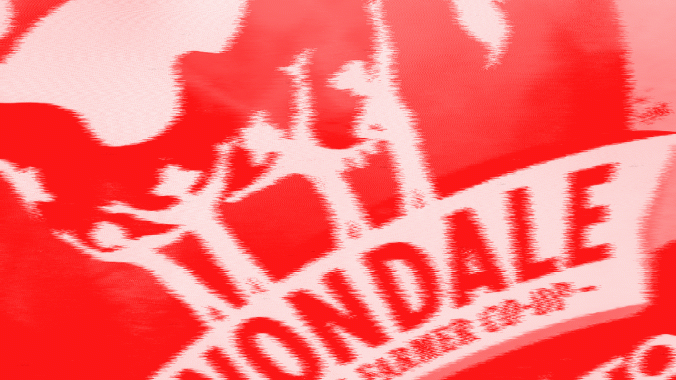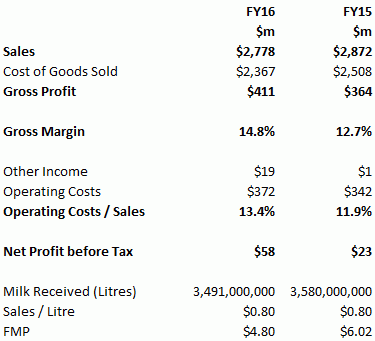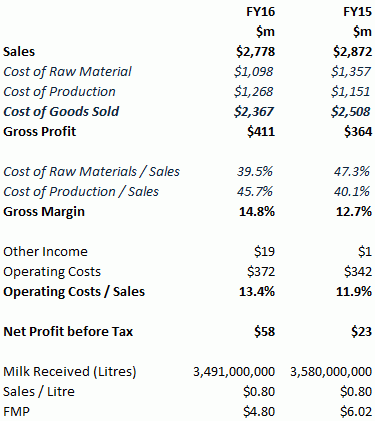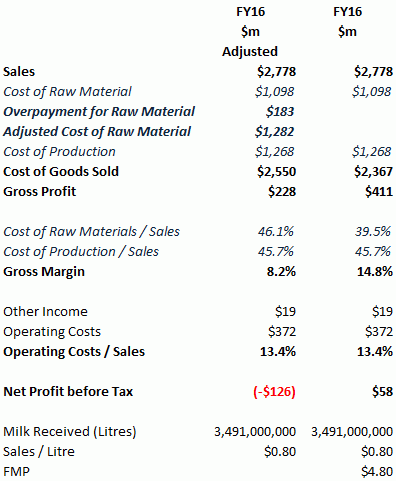
Next week, MG will host meetings for farmer supplier-shareholders to discuss its recently announced FY16 results. It’s the first set of annual financial results since the co-op’s partial listing and the accounts have seen some change, so Milk Maid Marian asked financial whiz, Michael Stapleton, to help make sense of the figures. This is not a light blog post but well worth reading right through to the end.
Michael is a Melbourne based Virtual CFO who helps business owners understand the drivers of their cash flow and make financially informed decisions. He is a founding member of the Association of Virtual CFOs and an occasional contributor of financial articles to Smart Company.

Michael Stapleton
Murray Goulburn (MG) released its unaudited FY16 report last week, reporting an increased profit. At face value this didn’t sound like a business that had to claw back $183.3m of payments already made to its supplier members.
So, I thought I’d take a look at their information to see what is going on behind the headline numbers.
Here is a snapshot of MG’s reported earnings:

MG produced an unchanged sales/litre return but a higher Gross Profit, Gross Margin and Net Profit in FY16. To do this, it paid a lower FMP of $4.80/kgms in FY16.
The FMP is derived through a pool payment system. Under a pool payment system, supplier members of a co-op receive what is left over once the cost of production and cost to run the business has been deducted from the revenue of the business.
MG’s magic profit
Do you see the trick? The final pool payment figure (and final profit figure) is worked out in reverse. In practice, a conservative pool price is set at the start of each year and adjusted as the year progresses. Supplier member expectations are managed by delivery of a final realised price usually somewhat better than the initial pool price.
MG’s Distributable Milk Pool for FY16 was $1.157bn. Of this amount, $1.1bn has been paid as Milk Payments, which are included in the Cost of Goods Sold as the Cost of Raw Materials. The other component of their Cost of Goods Sold is the Cost of Production – drying milk into powder, turning it into cheese, pasteurising and homogenising for drinking milk etc.
Incorporating this detail into MG’s earnings looks like this:

This additional layer of detail exposes an increase in the Cost of Production. At 45.7% of Sales, it is a big increase from FY15.
If this was my business, I would like to know what is happening to the operational efficiency of my factories.
Let’s see what MG’s earnings look like if they had not taken the $183.3m of payments to the supplier members out of their Cost of Raw Materials (they did this by capitalising the payment on their balance sheet as an asset – essentially as a prepayment of future FMPs):

The FY16 Adjusted column shows that retaining the $183.3m as a payment to suppliers increases the Cost of Raw Materials to $1,282m and lowers the Gross Profit to $228m.
A final Pre-Tax loss of $126m is realised. Quite a different position to that announced, and more in line with the issues faced by the business.
What hybridisation means for MG’s finances
FY16 is the first year MG has operated under a hybrid structure. Its results for FY16 are a child of the hybridisation process and I think some observations about the practical effects of hybridisation are relevant.
First of all, hybridisation has strengthened the financial position of the business. But, it has come at the cost of reduced flexibility, higher payments to the ATO than in the past and the difficulty of balancing competing interests.
The Profit Sharing Mechanism means MG has limited flexibility when deciding the split of the Distributable Milk Pool between FMP and Net Profit. Except in abnormal circumstances, MG must now record a Net Profit after Tax of between 3.5% and 7.5% of the Distributable Milk Pool.
In practical terms, as MG has elected to move from a Co-operative tax status to a Corporate tax status, the Profit Sharing Mechanism means MG must record a Pre Tax Profit of between 5% and 10.7% of the Distributable Milk Pool (this is the grossed up level of NPAT required to meet the 30% Company Income Tax obligation and achieve the 3.5% – 7.5% after tax profit outcome).
The pre-tax profit is shared between the ATO (first) and then suppliers and external investors. The ATO and the external investors receive 56% of the higher Net Profit before Tax, whilst the remaining 44% flows to supplier members.
In the four years prior to hybridisation, MG’s declared Net Profit before Tax averaged 1.9% of the Distributable Milk Pool (well below the 5 – 7.5% range now required). The tax paid averaged 0.05% of pre-tax profit, well below the 30% now required to be paid.
The trade-off for a stronger balance sheet has been a reduction in the Distributable Milk Pool flowing to supplier members in favour of the ATO and external investors.
Prior to hybridisation, MG’s purpose was clear – all its activities were for the benefit of their supplier members.
Since hybridisation, MG has to consider both the interests of the supplier member and those of the external investor. These interests will not always align and I think FY16 is a clear example of competing, not aligned interests.
I think the alignment of supplier member and external investor interests is vitally dependent upon the success of the value-add strategy.
Thank you very much to Michael Stapleton for this analysis of MG’s FY16 results and the impact of the new structure.
Very Enlightening
LikeLike
Simply the best explanation i have heard. I think this is a must read for all suppliers.
LikeLike
Love this blog MMM, and this is an excellent outline by Michael but don’t get too hung up on the ATO’s 30% takeout.
In simple terms, back in co-op days, you got $10 (say) and then paid your own tax thereon. Now you get $7 after providing for the ATO. Not much difference; the more pertinent factor is the effect of the hybridisation upon available distributions, I think? Perhaps Michael could explain it a little better – but otherwise, a very useful post.
LikeLike
There is two items of importance though…
The time from when the ATO takes the $3 or MGC takes it on their behalf from you as that makes a difference to cash-flow for the farmer during a financial year and can also impact a farmers ability to secure and then service debt during the year.
The other observation is that MGC can now use the milk pool as a buffer for the investor which is a big change to when they were a pure co-op.
As an addition I will offer that this change by MGC to a hybrid and using this approach has ensured poor succession management for dairy farming as it provides absolutely no incentive for younger farmers to move up the farm ownership chain if a supplier to MGC. Very detrimental to the sector in the medium to longer term.
MGC no longer serves its farmer/suppliers it has found a new master – the investment market.
LikeLike
terrific analysis Michael and Marian. well done
LikeLike
May be a silly question but is the money earned from the share float included in the “other income”?
LikeLike
Hi ab. The answer to your question is that there is no money “earned” from a share float. Money is “raised” from a share float. The equity base of the balance sheet increases (thus, the bookkeeping for a share float occurs through the balance sheet, not the profit and loss statement). The Other Income for FY16 is mainly the profit on the sale of Dairy Technical Services. Lastly, the only silly question is the one you do not ask. Hope this helps.
LikeLike
Great review.
I note that the cost of production increased by $117m from 2015 to 2016.
In addition, Operating costs increased by $30m.
So that is an extra $147m operating costs on both decreased revenue and decreased milk intake.
That implies some recent inefficiencies that have crept into production, and costs that are still there.
With milk intake volumes dropping due to farmers leaving MG, the problem they could still have, in offering a competitive price for full year 2017,
is they might be in for another loss in real terms. So does that mean another effort required to fake a profit for 2017.
With MG reviewing the farm support package, (and what a weird name for loans forced onto farmers), it appears they will have to write off most of the $183m loan in terms of no longer asking the farmers to pay it back, so expect it to appear as an extraordinary loss on the books for 2017.
One also wonders how management didn’t see it coming. They would/should have been tracking the expected net profit, and would be seeing the $126m loss as displayed by Michael Stapleton above. They should have adjusted the milk payment prices down as the season progressed. The $58m profit figure was only created at when they finally realized the dung had well and truly hit the fan, and is a fake profit to get match the 3.5%.
LikeLike